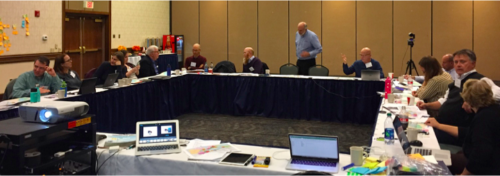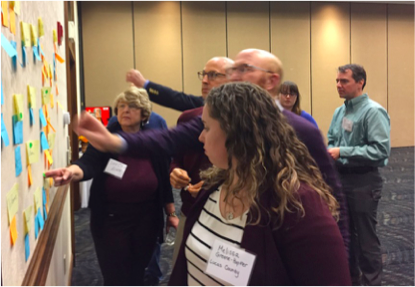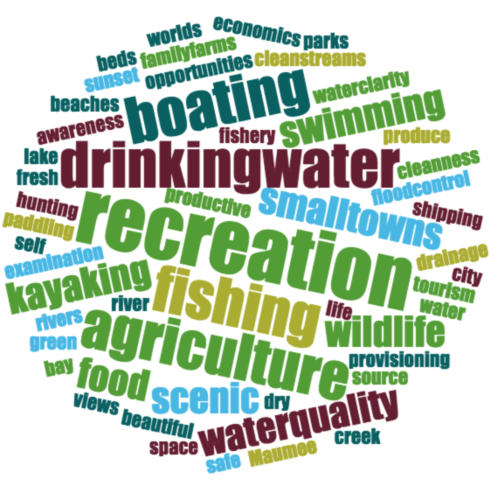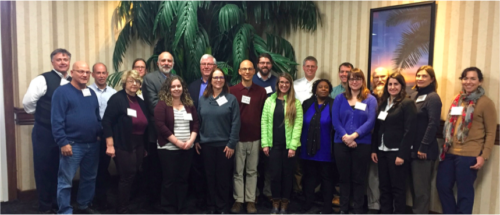Kick off workshop for Western Lake Erie report card project
Bill Dennison ·On 27-28 Nov 2018, Andrew Elmore, Alex Fries and I traveled to Sandusky, Ohio for the kick-off workshop for our Western Lake Erie and watershed report card project. We experienced some wonderful Ohio hospitality and had a productive workshop. This was the culmination of a project that I introduced in a previous blog about Lake Erie.
I enjoyed connecting to my Ohio roots and even met a couple of people from the city of Defiance, Ohio who helped me remember the restaurant in Defiance, Bud’s, where my family would meet our family friends on our way to summer vacations in northern Michigan. I also learned that the Ford Tri-Motor airplane that ferried people to Put-In-Bay from Sandusky still operated occasionally—this was my first airplane trip many years ago. We stayed in the Castaway Bay resort, which is primarily a summer destination, so it felt a bit like the movie “The Shining”. But the staff were extremely helpful and the workshop support was superb. Best of all, we had a spectacular view of Sandusky Bay just outside our hotel rooms.
Sandy Bihn, the Executive Director of Lake Erie Waterkeeper, organized both the venue and the invitations for attendees. I was impressed by both aspects of Sandy’s organizational skills. After hearing the introductions by the participants, I remarked that they had three common attributes: 1) System understanding supported by data, 2) Influence in various organizations and institutions involved in Lake Erie, and 3) Passion to help reverse the environmental degradation. This brought to mind the analogy that my friend, Peter Oliver, and I came up with in our book, “Dancing with Dugongs: Having fun and developing a practical environmental philosophy for teaching and research”. The analogy Peter and I used was the need to integrate the head (“We know”), the hands (“We can”), and the heart (“We Care”). What I saw in the workshop participants was using their heads (system understanding supported by data), their hands (influence in environmental issues) and their heart (passion for Lake Erie).

To start things off, Tom Bridgeman from the University of Toledo Lake Erie Center, provided an excellent summary of the existing efforts to synthesize and communicate complex data for Lake Erie, and the Great Lakes overall. In our background reading, we had run across pieces of each of the seven data summaries, but Tom provided the broader context for these efforts including who was responsible for producing them.
The first activity that we engaged in was SNAP! to identify and rank key values and major threats to Western Lake Erie and its watershed. Key values included drinking water and agriculture, followed by fishing, recreation, wildlife, drainage and flood control. Major threats included climate change, agriculture, water quality/harmful algal blooms/runoff, competing priorities, invasive species, and economic downturn. It was interesting that agriculture turned up as both a key value and a major threat.

We conducted a conceptual mapping exercise, with my favorite depiction being Lake Erie as a fish, with the watershed of the Maumee River being the fish tail. We also asked participants what a Western Lake Erie report card should aspire to be. We generated a fantastic word cloud of aspirational terms including: informative, factual, accurate, helpful, sustainable, concise, and multidimensional. In our discussions, we focused on the need for this report card effort to be distinct from other existing synthesis activities, to be geographically explicit with small scale reporting regions, to include both the watershed and the lake and to be communicated to a wide audience. We debated the tradeoffs of including Lake St. Clair and its major tributaries like the Thames River in Ontario, Canada into this report card effort.

We did some stakeholder mapping to identify the various groups and organizations that we should engage with in the development of the report card. There are a number of universities in the region, multiple state and federal agencies, a number of municipalities, and non-governmental organizations with expertise and interest in Western Lake Erie and its watershed. We discussed developing environmental literacy principles for Western Lake Erie and its watershed. We established that groups with high interest and influence need to effectively communicate, groups with high interest but less influence need to align with other groups and groups with high influence but less interest need to be encouraged to participate through buy-in with partners.
Andrew Elmore led us in a discussion to identify the potential boundaries and principles for developing boundaries for reporting regions in Western Lake Erie and its watershed. I provided a short overview of the project that the Integration and Application Network graduate student Vanessa Vargas-Nguyen is undertaking as part of her PhD research. Vanessa is developing Social Network Analysis of Western Lake Erie people associated with this report card project. She is also involved in a collaborative graduate student pursuit project on Lake Erie, supported by the National Socio-Environmental Synthesis Center (SESYNC).

We ended the workshop with a song that I based on “Old Folks at Home” by Stephan Foster. The rhyming of the “Maumee River” with the “Swanee River” stimulated me to adapt this song. The lyrics are as follows:
Way Up Into the Maumee River
William C. Dennison & Stephan Foster
28 Nov 2018
Way up into the Maumee River,
Far, far away.
That’s where nutrients are too high
But that’s not where they stay
The nutrients come down into Lake Eire
Sadly I say
And the HABs they cause are dreary
Which chases all the people away
Gotta go into the Maumee watershed
Far, far away
Cause that’s where all paths led
For the report card project we started today
The world is not so sad and dreary
Ev’rywhere I roam
When you use science beyond theory
And it gets me close to home
And it gets me close to home
And it gets me close to home
About the author
Bill Dennison

Dr. Bill Dennison is a Professor of Marine Science and Vice President for Science Application at the University of Maryland Center for Environmental Science.
Next Post > Gulf of Thailand Study Tour
Comments
-
Rick Graham 7 years ago
Very nice update, we look forward to "The Journey" for the Western Basin Report Card Project.
Thank you,